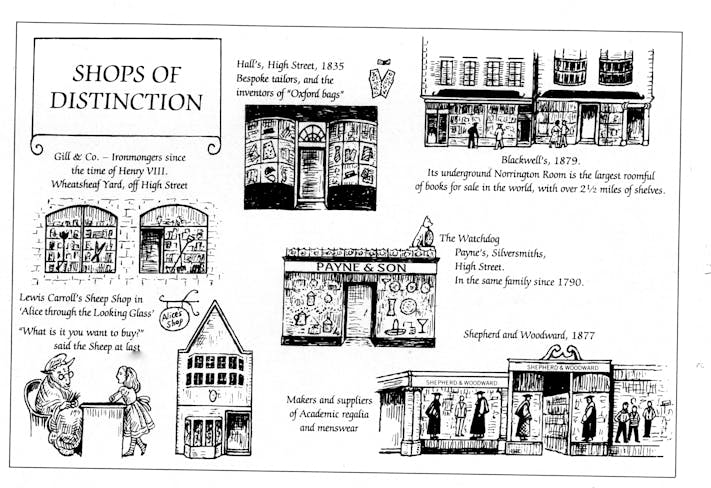Shops of Distinction

Gill & Co. was originally the business of the Smythe family, prominent in Oxford affairs in the 16th and 17th centuries. The business dates back to 1530. Thomas Smythe, a Chamberlain in the 1570s, was committed to Oxford Castle for ‘denying obedience to the Vice-Chancellor’. He was released on expressing his regret and promising to mend his ways. On the same day, and probably because of it, the Town Council granted him rights to the City swans for the next 21 years provided he paid them 4 fat cygnets annually. Relations having improved over the past few hundred years, Gill & Co. have a long tradition of trade with the Oxford colleges. [Sadly, since this text was written Gill's has closed its Oxford city store, though it still has a branch in Chipping Norton.]
A ‘bespoke’ tailor is one who makes clothes to the specific orders of his customers, who bespeak them, ie. order them from him. Hall’s (now defunct) were the official tailors to the exclusive Bullingdon Club and Christ Church Beagles, and were one of four shops chosen by the Duke of Windsor (a customer when an undergraduate at Magdalen) to have the Appointment to the Prince of Wales. Oxford ‘bags’ were very much the vogue in the 20's-30’s – floppy grey trousers which became wider and wider until they reached the ankles. It is said that the original idea was to wear them over one’s hunting breeches (or golfing knickerbockers), so as to be able to get out onto the field straight from a tutorial. Other innovations by Hall’s included the ‘Rush-in’ shirt – an imitation of Russian aristocratic style, with high collar and buttons at the side, and wide-brimmed fur hats, as worn by Compton Mackenzie.
Payne’s began in Abingdon and Wallingford, and moved to Oxford in 1888. They probably brought the watchdog with them at that time. A passer-by once came in to tell them the history of the dog. This was in 1955, and they have since lost the notes they made, so would be grateful for any information that anyone can give them. The clock does not show a time. A zealous painter once painted in some hands, but so many people came in to tell them their clock was wrong, that they had to paint them out.
Shepherd & Woodward. Arthur Shepherd bought the business from a journeyman tailor, Mr Brockington, who had a shop in the Cornmarket. They moved to the High Street in 1927. Their local workshop produces gowns and hoods, as well as executing such charming commissions as the pennant for the Lord Mayor’s car, or, a several years ago, 600 cricket pullovers for a Japanese delegation. They have made gowns for royalty, and in 1977 (their centenary year), remade the Chancellor’s gown for Harold MacMillan, and presented it to the University. One of their longest surviving members of staff was Harold Isaac, who started as an apprentice in 1902, on a salary of one shilling a week. This rose to two shillings in his second year, and three in his third. He retired in 1975 (…hopefully not on 73 shillings a week!).
Charles Dodgson (aka Lewis Carroll) was a Christ Church don. The little 15th century shop almost opposite Christ Church became the shop where Alice (based on Dodgson’s real life young friend Alice Liddell) finds herself with the Ewe in Alice Through The Looking Glass. Our sketch is taken from the original illustration by Sir John Tenniel. Now a gift shop, ‘Alice’s Shop’ specialises in ‘Alice’ memorabilia.



